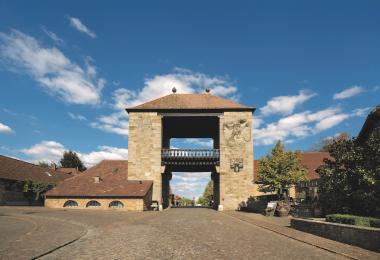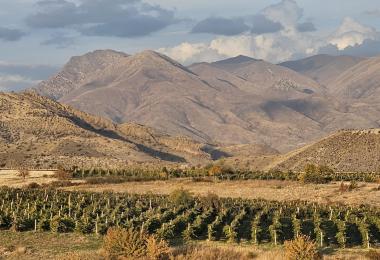A large quantity of shrivelled, raisin-like grapes was harvested from the Baron of Leisser’s vineyard in Burgenland and used to produce an extraordinary sweet wine in 1526, the first recorded Trockenbeerenauslese in the region. Prince Paul I Esterházy acquired the estate along with this precious wine more than a century later in 1653. Whenever this treasured golden liquid was served at noble festivities, the barrel was topped up with boiled pebbles to keep it from oxidizing. This luscious sweet delicacy was enjoyed repeatedly for no fewer than 326 years until the last drops were tasted at the Forchtenstein Castle in 1852.
The city of Rust on the western shore of Lake Neusiedl in Burgenland has been famed for a special form of Trockenbeerenauslese called Ruster Ausbruch since the mid 16th century. Ruster Ausbruch was coveted at courts throughout the Holy Roman Empire and the city’s winegrowers had a faithful network of trade contacts. In 1524, Queen Maria of Hungary and Bohemia granted Rust’s winegrowers the privilege of branding their wine casks with a large, cursive “R”, an early form of designation and protection of origin. The excellent reputation of the sweet Ruster Ausbruch ensured prosperity in the city. In 1681, the citizens bought the title and privileges of a “Royal Free City” for 60,000 guilders and 500 Eimer (about 30,000 litres) of Ruster Ausbruch from Emperor Leopold I. Today, this illustrious sweet wine has its own protected designation of origin, Ruster Ausbruch DAC, and still bears the historic, cursive “R”.
Naturally sweet wine
Austria’s international reputation for superb sweet wines continues today. Trockenbeerenauslese and Beerenauslese are only two of the country’s broad assortment of naturally sweet wine (Prädikatswein) categories. What all of these specialties have in common is a delicious play of natural sweetness with bright acidity and superb potential for extended bottle ageing.

Grapes for Schilfwein are dried on straw mats sourced from the reed belt surrounding Lake Neusiedl / Credit: ÖWM - Anna Stöcher
There are essentially four ways that Austrian quality wines can achieve sweetness naturally. Wines can be made from late harvested grapes, grapes affected by noble rot, dried grapes, or grapes that have been frozen on the vine. All four methods are included in Austria’s hierarchy of Prädikatsweine.
Naturally sweet wines are produced in all of Austria’s wine regions, but they are a real specialty on the east side of Lake Neusiedl in northern Burgenland. Since 2020, the Neusiedlersee DAC and Neusiedlersee DAC Reserve protected designations of origin also include sweet wines from all Prädikatswein categories with a minimum of 45 g/l residual sugar. The smaller designation of origin “Seewinkel” is permitted for nobly sweet Neusiedlersee DAC Reserve, if the grapes come from the municipalities Apetlon, Illmitz or Podersdorf.
Late harvest
Austria produces two types of fruity, half-dry to medium sweet Prädikatswein: Spätlese (late harvest) and Auslese. For these categories, grape bunches are allowed to hang on the vine as long as possible in autumn so the natural sugar in the grapes becomes concentrated. The grapes for Auslese are picked with a little higher sugar content than Spätlese and all immature, diseased or flawed berries are removed by hand (the name Auslese comes from “ausgelesen”, meaning selected).
Botrytized grapes
Production of the botrytized sweet wine categories Beerenauslese, Trockenbeerenauslese and Ruster Ausbruch requires the magic of nature and special care in both the vineyard and cellar. Under the right climatic conditions with misty mornings and sunny afternoons, grapes can become affected with Botrytis cinerea, also called noble rot. This desirable fungus attacks grape skins and makes them porous. The grapes shrivel causing flavour compounds, sugar and acidity to become concentrated. Grapes are selected by hand over multiple passages to obtain the most desirable degree of Botrytis and concentration. Once pressed, fermentation of the intensely sweet juice can demand several attentive months.

Eiswein is made from grapes that have frozen on the vine / Credit: ÖWM - Christian Bauer
Dried grapes
The sweet wine specialties Strohwein and Schilfwein are made by drying ripe, non-botrytized grapes for a minimum of three months on straw (Stroh) or Lake Neusiedl reeds (Schilf) before being pressed and fermented. During the drying period, grapes are inspected regularly and rotten ones are removed by hand.
Frozen on the vine
While all other Prädikatswein specialties have long been fermenting in the cellars, the healthy grapes for Eiswein wait patiently on the vine for bitterly cold, frosty nights. After the temperature drops down to well below freezing for several hours, water in the grapes freezes. The grapes are pressed while still frozen and water content remains crystalized during pressing to yield lusciously sweet and intensely flavoured juice. The resulting wines have a nearly limitless ageing potential.
All grape varieties permitted for quality wine production in Austria can also become sweet wines. Welschriesling is one of the most popular varieties due to its ability to retain acidity, even when very ripe. One also finds excellent sweet wines form varieties like Chardonnay, Weissburgunder or Bouvier, as well as from aromatic grapes like Muskateller, Traminer, Sauvignon Blanc, and Scheurebe. Sweet wines made from Riesling that grows along the Danube is an exciting rarity. The national hero, Grüner Veltliner, shows off it impressive versatility in all Prädikatswein categories.

The many styles of Austrian sweet wine offer opportunities to pair with both sweet and savoury foods / Credit: ÖWM - Carletto Photography
Culinary treats
Great sweet wines have unimagined culinary talent. Although they are most frequently paired with desserts, they can also be good matches with savoury dishes. Poultry liver, sautéed or as a pâté, adores botrytized sweet wine. Elegantly structured Spätlese and Auslese can wonderfully highlight the exotic spice of many Asian dishes. And last but not least, the piquant, zesty edge and intense flavour of blue cheese or washed-rind cheese find perfect balance with Austrian Prädikatsweine.
Serve the wines cold and taste your way to your favourite combination!








